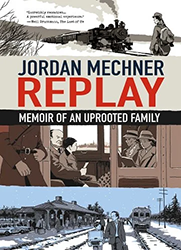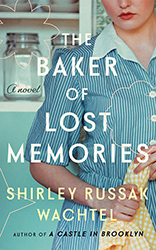Leela Corman’s newest graphic novel interweaves the lives of Jewish characters in the final years of World War II and its immediate aftermath. Formally, Corman adopts an expressionist painting style, a move that not only makes the pages disturbingly beautiful but also speaks to how trauma resists traditional forms of representation. Victory Parade is a stunning story that demonstrates the ways in which Holocaust trauma’s reach in America fractures those it touches.
Each of the characters in Corman’s graphic novel confronts the reality of antisemitism and Holocaust trauma in a different yet not altogether dissimilar fashion. Rose, a true “Rosie the Riveter,” finds solace in her affair with a disabled army vet named George. Ruth, Rose’s adopted daughter who managed to escape Germany and now lives with Rose in Brooklyn, struggles under the confines of gender norms and misplaced American rage. Ruth’s husband, Sam, liberated a concentration camp, an experience that now haunts him at home. Eleanor, Rose’s daughter, grows up in the quagmire of these compounding traumas.
It is the moments in which Corman dives fully into expressionist representation that speak most to the way trauma dismembers and distorts. After sleeping with George for the first time, Rose returns home and takes a bath. Over the course of two pages, Corman depicts Rose’s body splitting, with separate body parts dismembered and floating away from each other. These pages contain no text, which suggests that trauma resists language and manifests somatically. Rose’s fragmentation comes after Corman reveals that George has lost his leg in the war.
Corman concludes the novel by focusing on Rose’s husband. Over the course of the final thirty pages, she paints the horrors of the Holocaust from Sam’s haunted perspective. Concentration camp prisoners transform into ghosts, disembodied hands grab Sam as he dreams, and Holocaust victims carrying their own dismembered heads compel Sam to “tell them you saw me!” These final pages, bookended by mundane events like taking Eleanor to Coney Island and picking up a passenger in his taxi, reflect the way Sam’s trauma seeps into his everyday life, distorting and fragmenting the world around him. As Sam drives away with his passenger, a fellow war vet who “saw some real action,” Sam replies that he saw “nothing special” as a cloud filled with the bodies of Holocaust victims plumes out from behind the car.
Dr. Megan Reynolds is the Development Manager for the National Book Foundation. Before joining the National Book Foundation, Megan Reynolds served as the Development Coordinator at Jewish Book Council. Megan holds a Ph.D. in English from the University of Oregon and BA in English with minors in Creative Writing and Spanish from Trinity University. She is originally from New Mexico and now lives in New York City.





